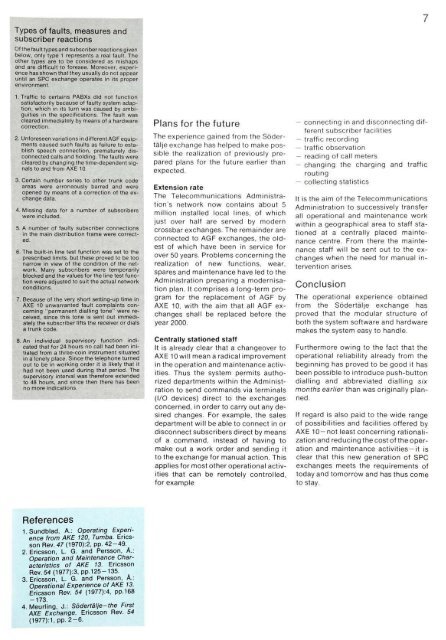ericsson review - ericssonhistory.com
ericsson review - ericssonhistory.com
ericsson review - ericssonhistory.com
Create successful ePaper yourself
Turn your PDF publications into a flip-book with our unique Google optimized e-Paper software.
Types of faults, measures and<br />
subscriber reactions<br />
Of the fault types and subscriber reactions given<br />
below, only type 1 represents a real fault. The<br />
other types are to be considered as mishaps<br />
and are difficult to foresee. Moreover, experience<br />
has shown that they usually do not appear<br />
until an SPC exchange operates in its proper<br />
environment.<br />
1. Traffic to certains PABXs did not function<br />
satisfactorily because of faulty system adaption,<br />
which in its turn was caused by ambiguities<br />
in the specifications. The fault was<br />
cleared immediately by means of a hardware<br />
correction.<br />
2. Unforeseen variations in different AGF equipments<br />
caused such faults as failure to establish<br />
speech connection, prematurely disconnected<br />
calls and holding. The faults were<br />
cleared by changing the time-dependent signals<br />
to and from AXE 10.<br />
3. Certain number series to other trunk code<br />
areas were erroneously barred and were<br />
opened by means of a correction of the exchange<br />
data.<br />
4. Missing data for a number of subscribers<br />
were included.<br />
5. A number of faulty subscriber connections<br />
in the main distribution frame were corrected.<br />
6. The built-in line test function was set to the<br />
prescribed limits, but these proved to be too<br />
narrow in view of the condition of the network.<br />
Many subscribers were temporarily<br />
blocked and the values for the line test function<br />
were adjusted to suit the actual network<br />
conditions.<br />
7. Because of the very short setting-up time in<br />
AXE 10 unwarranted fault <strong>com</strong>plaints concerning<br />
"permanent dialling tone" were received,<br />
since this tone is sent out immediately<br />
the subscriber lifts the receiver or dials<br />
a trunk code.<br />
8. An individual supervisory function indicated<br />
that for 24 hours no call had been initiated<br />
from a three-coin instrument situated<br />
in a lonely place. Since the telephone turned<br />
out to be in working order it is likely that it<br />
had not been used during that period. The<br />
supervisory interval was therefore extended<br />
to 48 hours, and since then there has been<br />
no more indications.<br />
Plans for the future<br />
The experience gained from the Sodertalje<br />
exchange has helped to make possible<br />
the realization of previously prepared<br />
plans for the future earlier than<br />
expected.<br />
Extension rate<br />
The Tele<strong>com</strong>munications Administration's<br />
network now contains about 5<br />
million installed local lines, of which<br />
just over half are served by modern<br />
crossbar exchanges. The remainder are<br />
connected to AGF exchanges, the oldest<br />
of which have been in service for<br />
over 50 years. Problems concerning the<br />
realization of new functions, wear,<br />
spares and maintenance have led to the<br />
Administration preparing a modernisation<br />
plan. It <strong>com</strong>prises a long-term program<br />
for the replacement of AGF by<br />
AXE 10, with the aim that all AGF exchanges<br />
shall be replaced before the<br />
year 2000.<br />
Centrally stationed staff<br />
It is already clear that a changeover to<br />
AXE 10 will mean a radical improvement<br />
in the operation and maintenance activities.<br />
Thus the system permits authorized<br />
departments within the Administration<br />
to send <strong>com</strong>mands via terminals<br />
(I/O devices) direct to the exchanges<br />
concerned, in order to carry out any desired<br />
changes. For example, the sales<br />
department will be able to connect in or<br />
disconnect subscribers direct by means<br />
of a <strong>com</strong>mand, instead of having to<br />
make out a work order and sending it<br />
to the exchange for manual action. This<br />
applies for most other operational activities<br />
that can be remotely controlled,<br />
for example<br />
— connecting in and disconnecting different<br />
subscriber facilities<br />
— traffic recording<br />
- traffic observation<br />
- reading of call meters<br />
— changing the charging and traffic<br />
routing<br />
- collecting statistics<br />
It is the aim of the Tele<strong>com</strong>munications<br />
Administration to successively transfer<br />
all operational and maintenance work<br />
within a geographical area to staff stationed<br />
at a centrally placed maintenance<br />
centre. From there the maintenance<br />
staff will be sent out to the exchanges<br />
when the need for manual intervention<br />
arises.<br />
Conclusion<br />
The operational experience obtained<br />
from the Sodertalje exchange has<br />
proved that the modular structure of<br />
both the system software and hardware<br />
makes the system easy to handle.<br />
Furthermore owing to the fact that the<br />
operational reliability already from the<br />
beginning has proved to be good it has<br />
been possible to introduce push-button<br />
dialling and abbreviated dialling six<br />
months earlier than was originally planned.<br />
If regard is also paid to the wide range<br />
of possibilities and facilities offered by<br />
AXE 10 —not least concerning rationalization<br />
and reducing the cost of the operation<br />
and maintenance activities —it is<br />
clear that this new generation of SPC<br />
exchanges meets the requirements of<br />
today and tomorrow and has thus <strong>com</strong>e<br />
to stay.<br />
7<br />
References<br />
LSundblad, A.: Operating Experience<br />
from AKE 120, Tumba. Ericsson<br />
Rev. 47 (1970):2, pp. 42-49.<br />
2. Ericsson, L. G. and Persson, A.:<br />
Operation and Maintenance Characteristics<br />
of AKE 13. Ericsson<br />
Rev. 54 (1977):3, pp.125-135.<br />
3. Ericsson, L. G. and Persson, A.:<br />
Operational Experience of AKE 13.<br />
Ericsson Rev. 54 (1977):4, pp.168<br />
-173.<br />
4. Meurling, J.: Sodertalje-the First<br />
AXE Exchange. Ericsson Rev. 54<br />
(1977):1,pp. 2-6.
















